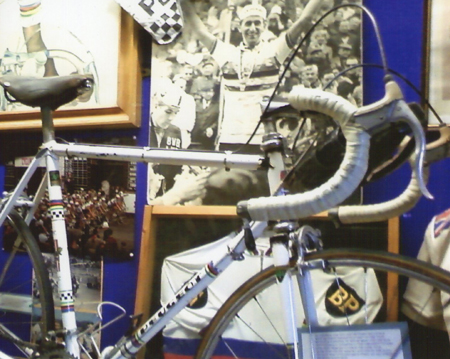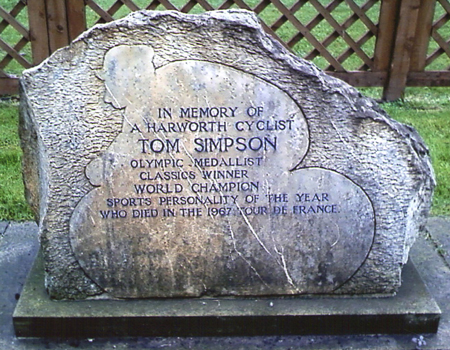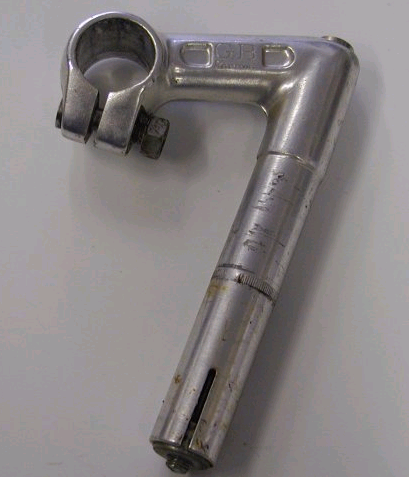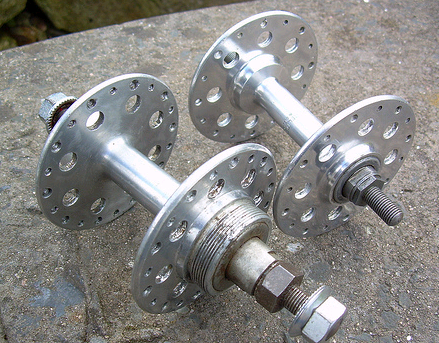Vol. 2, Issue 32 - March / April 2011
Posted: Monday 28th March 2011
Humble Pie time. Mick Madgett sent in the following in response to my remark that any changer would index if used with index levers:
I’m afraid that you’ve made a not uncommon mistake regarding rear mechs and indexing. While the lever moves a set amount of cable, the movement this generates at the mech is governed by the precise dimensions of the ‘deformable parallelogram’ (main body pivots), and also the length and angle between the cable stop and the clamp. To demonstrate this, try clamping the cable the ‘wrong’ side of the clamping bolt! Different manufacturers have different ‘pull-ratios’ and most ‘cross-correlations’ are purely by chance rather than design!
I am looking for an Airlite small flange front hub, 32 hole in good condition with intact chrome on the barrel – details above
One day towards the end of last year Patricia and I took a day-trip to London (45-minutes on the train from Cambridge). We wanted to visit Condor cycles to check out some of their clothing range and retro models of the Paris Galibier and Tour de France, as well as the studio of James Straffon, an artist in St John’s who produces some interesting cycle-related work http://www.no-gallery.co.uk/ Sadly, we missed him but saw some of his paintings. Condor cycles own the rights to the Paris name and have introduced some replica versions in the last couple of years. These are now built by a respected frame builder in Italy.
For lunch we had heard there was a cycle-themed cafe nearby so thought this was an opportunity not to be missed, especially as the vegetarian options on the menu looked better than the norm. The name of the emporium is Look Mum No Hands and it is based on Old Street, an extension of the ‘fixie famous’ Clerkenwell Road http://www.lookmumnohands.com/ . It was a great experience to have lunch in a cycle-friendly environment and to be surrounded by classic bikes of various eras. It was interesting to see brand new Brooks Swallow saddles being customised whilst we dined – in this case stamped with ‘L M N H’.
We used shank’s pony and the buses to get around and everywhere we looked there were fixed-wheel and single-speed bikes ridden by men and women alike – the cult has really taken off in the last few years. One weekend we plan to take some bikes down and join in the fun especially as London is much more rideable since the Congestion Charge was introduced by Ken Livingstone.
Apart from the local premises of Messrs H.R.Morris, Lipscombe, Rivetts and Leach Marathon, we had in Leytonstone another cycle specialist builder, Ron Neypier, who had a small shop/ workshop in Grove Green Road. I remember him very well as around age 13/14 I used to ride a delivery bike for our local grocer (who had a shop further down the same road) and on Mr Mattick (the grocer)’s instructions, I sometimes used to take the bike to Mr Neypier after it had developed an ailment, usually involving the brake gear. This inevitably resulted in a great deal of bad temper accompanied by much swearing as the lightweight cycle “specialist” battled with the agricultural aspects of rod operated braking. Looking back on these times of fifty years ago, I often wonder what became of the Neypier establishment. I’m fairly sure the business disappeared even before I began my apprentice days in 1959, and had certainly gone ten years later when I married Carole and moved away from north-east London to Huntingdonshire.
THE TOM SIMPSON MUSEUM
By Roger Stevens
There are many other smaller items also – Tom’s trade mark bowler hat, his racing jersey, race route notes and much more. It’s well worth a visit if you are in the area. At the entrance to the club grounds is a stone memorial, similar to the one on Mont Ventoux.
He is buried in the local cemetery, just a couple of minutes drive away. The grave is marked by an appropriate memorial headstone.


The collection has been put together by Dave Marsh, a local bike shop owner and ex-racer himself.
The Club address is: Harworth & Bircotes Sports Pavilion , Scooby Road, Harworth.
Leafing through the pages of history by Steve Griffith
Old Cycling magazines
The more time I spend on research, the more of my leisure time I tend to spend reading old cycling magazines. There is no better way to pass a winter’s evening or a day when riding is not possible than immersing oneself in a past volume. I am lucky in that I have access to pretty much complete runs of the big three magazines i.e. Cycling, The Bicycle and the CTC Gazette. There are of course other magazines, notably Sporting Cyclist and The Cyclist (edited by EJ Camm from the late 30’s) but it is the three former ones that I find most useful.
What I find extremely interesting is the differences between them and how they all in their own way reflect British social history. Starting with Cycling, the real survivor founded in 1891 and still going strong today. It is first and foremost to me cycling’s establishment’s paper. Conservative with a small and a large ‘C’. For example it was hostile for many years to mass start racing and it took until 1955 to provide any real coverage of the Tour De France. Their attacks on the BLRC are quite incredible to read today, suggesting all cycle sport would be
wiped out as the government would ban all competitive riding. From a research point of view the advertisements are about the most useful feature. I find their equipment reviews generally unhelpful as they tended to be uncritical, I assume out of fear of losing advertising revenue. I know the cycle show issues are sought after but it is not always realised these could be spread over 3 issues. Also these were sometimes just taken from manufacturers press releases. I have come across several instances of reviews in rival publications which read the same word for word!! Patterson drawings are still a highlight even though many of the touring articles they illustrated have dated very badly. Patterson also drew for the CTC Gazette but his best work is in Cycling simply because they paid far better. Like other magazines, the readers’ letters are of interest as a barometer of how the ordinary cyclist thought. I particularly enjoy controversies over subjects like gearing or lighting which can run over several issues.
Generally if magazines were period bound they will lack covers and in some cases advertisements. In the case of Cycling this could run to as much as 8 pages per issue. Thus there is a real benefit in getting unbound copies even through due to poor paper quality and rusting staples they need to be bound to preserve. NB by shopping around you should be able to get volumes professionally bound for about £20. It is interesting to note that until the 1950’s the cover was viewed as a wrapper which protected the magazine and thus would be thrown away.
As an all round balanced touring and racing read I really enjoy The Bicycle (1936 to 1955 when it was absorbed into Cycling). Much of the writing e.g. Jock Wadley, Bill Mills and Rex Coley (Ragged Staff) is still fresh. They were far more welcoming of change e.g. supporting the BLRC and the founding in 1955 of the RSF (Rough Stuff Fellowship). There is more focus on continental racing and a greater openness to innovation in cycle design. The pre-WW2 broadsheet issues are especially worth seeking out but be careful, they are printed on the poorest of paper and tear far too easily
The CTC Gazette had the benefit of not being tied to advertising, thus their equipment reviews are far more useful . However, the quality of the magazine is a direct reflection of the financial fortunes of the club. Thus from the early 50’s onwards the magazine dramatically declined in size and interest. The heyday for the CTC Gazette was the 1930’s, richly illustrated with the work of Frank Patterson, Charles Harper and Reg Gammon, G H Stancer, the editor created a high quality publication. Frank Urry’s column “Notes of a Nomad” come closest for me in describing the joy of cycling. Reading some of the reader’s letters makes you realise that some things don’t change, like debates about gearing. Post-war the magazine never achieved the same heights despite a growing membership. Throughout the post-war period the CTC had a morbid fear of increasing the subs which resulted in a smaller and smaller magazine until the decision was made to go bi-monthly in 1964 and be re branded as Cycletouring.
An example of the usefulness of advertisements in understanding company developments . When I was researching the Harden Tool and Gauge Company I was able to trace the company’s development by their advertisements which pretty much changed monthly. They used adverts to get across key messages e.g. their hubs are maintenance free, and announce new products. Sometimes even if you start out with the firm intention of researching one subject you can get distracted and this can be extremely time consuming so maybe these magazines should come with a warning!
I asked John Spooner whether he used glue or tape for his tubs: For tubs I have always used glue, he said, I tried tape back in 1959 and hated it, and again in the 80’s, as several riders used it. I gave it another go and still didn’t like it.
Problems mainly were difficulty with centering the tub, whereas glue lets you move the tub about. The main problem I found when I punctured and then removed the tub, some of the tape came away with the tub and got all stuck together making it impossible to reuse, meaning the spare tub had no adhesive to stop it rolling off.
People say glue is messy, as I found when first using it. I read the instructions, “coat rim and base tape with rim cement “. That was horrendous, with new Clement Elvezias I got in a right mess! Then a clubmate told me to pre-stretch the tub first. That’s the secret, its best to pre-stretch the new tub then fit to rim, pump up hard and leave for an hour or two. Then it will fit easily when needed. Some people don’t coat all of the rim at once, preferring to fit the tub dry then work round the wheel pushing the tub across a small section and brushing the glue under the tub, then reseat it and move on round bit by bit. Obviously your spare tubs should be ones that have been already used or at least well stretched !
Speaking Up For … Part 6 Steve Griffith
{Another is the series championing underrated or ignored cycle components)
GB forged stems
A stem breaking while riding is potentially one of the most dangerous things that can happen as I found out to my cost a few years ago when a two piece Reynolds stem came apart. Fortunately there was no other traffic but holding handlebars unattached to the frame lead to a nasty groin injury.

Ever since then I have avoided using any two-piece stem. Most of my bikes are fitted with GB stems. I know the earlier Spearpoint and the Girder are sought after for 40’s & 50’s rebuilds but I want to champion the forged allen key stem from the 60’s and 70’s.
These were fitted as original equipment to many lightweights of the period and always seem to me one of the most trouble free components. Even after years of use they will still polish up and I have always found them easy to mate to bars (unlike Cinelli stems even to their own bars can be a struggle). I really rate GB bars, which again seem trouble free and comfortable. Most have the model name at the end of the bar. By the late 60’s GB were only making a few models Maes being the most common, the Ventoux (a deeper drop), the Randonneur (slight upward curve on the centre part) and Touring (very shallow drop).
Koyokuto (KTT) Pedals
I have seen several times buyers pick up these pedals at cycle jumbles and then put them back with a murmur of “oh they are Japanese”. I can only assume they were hoping for something Italian….
KTT made both quill and track pedals in the 70’s and 80’s. They had some success breaking into the US market but very little here due to our innate conservatism I suspect. . The quill pedals are slightly wider than most European ones and are very long lasting. Another example of Japanese improvement to a European design the top model the Pro Ace (a Campag copy even down to the water repelling threads at crank end)) can be identified by the dust cap, which has very distinctive slots (see illustration). Don’t lose them because they seem to use a unique thread!
I really rate the KTT steel track pedals a classic simple design extremely durable they have survived several years of being on my teenage son’s bike.

BHC Racelite Hubs
When you mention British Hub Company (BHC) most people think of the top of the range Airlites or maybe the Solite, which were made in both tandem and solo version. Both of these were three-piece hubs the former chrome barrel and alloy flanges. In the late 50’s BHC introduced the first British all alloy large flange one-piece hub, the Racelite. With its round cut-outs it was visually the same as the French Normandy, I suspect this was where BHC got the design. Unlike the Airline the Racelite was not made in a quick release version, which in the 60’s became the most popular option for club cyclists. No doubt this contributed to BHC decline and their eventual closure in 1969.
The Racelite was BHC’s last hub and is normally found in gear/fixed versions, drilled 32/40; the centres are engraved ‘BHC Racelite’. It was advertised fairly extensively in the cycling press in the late 1950’s, especially the CTC Gazette, the main selling point being its lightness compared to steel hubs. A trouble-free and long-lasting hub and one that looks exactly right for lightweights from about 1957 to the late 60’s,
Cycling is an international activity, and not just the sporting/racing scene. I realised this when I was researching the website of a collector of low-pro machines who lives in Sweden. He visited Moscow with his wife, who is from that city, and had some images of members of the the fixie cult over there, where they are known as alleycats, as well as in Sweden. The cult seems to be popular just about all over the world now as well as here and in the States, I have also seen images of female ‘alleycats’ from the Phillipines looking very racy, stylish and ready to take anyone on.
The new ‘fixie’ scene has also revived bicycle polo as a sport and we have an active club here in Cambridge where they have an indoor court (on short lease). In February they are organising a tournament over two days with entries from all over the UK, France, Holland and probably Germany. I have had a few goes on the bikes which are great to ride, especially the ones on fixed. The gear is about 36” so you can accelerate very quickly, which is what it is all about. This is altered to suit the length of the court. One day when no one is around I will get a mallet and have a go at hitting a ball round the court. I don’t think I will ever match the art of dribbling the length of the court and then smartly passing the ball under the bottom bracket to another player.
The premises are shared with the Romsey Town Rollerbillies who have a track laid out in the other half but I will have to leave you to Google that one yourself or else risk getting too far off message. Not for the faint-hearted though! The really stylish skaters arrive at the track on a fixed-wheel bike – never like that in my days, what is the world coming to!
Mark Hudson – I’m after two pre-war front brake calipers and matching levers. Condition is not hugely important, as long they are complete and salvageable. I have various parts to swap, or cold, hard cash.
Ted Haynes is restoring a George W Stratton machine frame number 653.368 and is desperate for some period transfers. chrisandtedhaynes@tiscali.co.uk
There are some snippets of cycling news at: http://www.britishpathe.com/record.php?id=8863 Sadly, they are snippets and you have to subscribe to see the whole extract.
I asked Bryan Clarke about the first four issues of The Coureur. He thinks that the sequence goes as follows. The first Monthly edition (May 1957) states that it is Vol. 1 – No. 5. So that means there were four issues before this and they were the quarterly ones. Bryan has Winter 1955, Spring 1956 and Summer 1956. Therefore he guesses he is missing the Autumn 1956 edition, which if his memory is correct has an article featuring Brian Robinson. When it stopped in 1968 it was amalgamated with Cycling (Weekly) for a period of time. I asked Bryan because I would love a set of the first four quarterly editions and I have the Summer and Autumn ones.
I would like to get a copy of Spring and Winter in very good condition to make up my set of four. These first four were just called Coureur with ‘J B Wadley’s’ written through it.
Bryan has for sale Trevor Jarvis International TT FRAME 1980 (Flying Gate) 23” with original OMAS headset. Original paintwork that has been retouched. Columbus SL tubing, weight 6lbs. Mini stays a little knocked. Superb to ride, reluctant sale. There cannot be many early models in this condition, now over thirty years old. Further details on Classic Lightweights ‘Readers Bikes’ at https://www.classiclightweights.co.uk/bikes/tj-gate-rb.html.
Brian Redfern – I recently posted a message in a Cycling Weekly forum requesting any information regarding the location and photos of the Cafe den Engel in Ghent but had zero replies so perhaps “old” cyclists don’t read the forums!
The only reply I did receive was an email from Ghent regarding the Cafe which is being threatened with demolition and a link to their Facebook site. There are probably other “old” racing cyclists who stayed at the Cafe and might be interested in what’s happening but not sure where to post the information!
Dear Sir
I see you ask a question on café Den Engel. If you go on Facebook you will see this pub
http://www.facebook.com/#!/pages/Red-Cafe-Den-Engel/188013354555524
People want to knock it down for a new building. Therefore support is asked on the site to prevent this. Roger Van den Bulcke, Sint-Amandsberg.
Posted: Monday 28th March 2011
This article appears in the following categories.
Upcoming Events
Whether you are looking for a gentle social meet up, or a 100-mile ride browse the community’s upcoming events and plan your next weekend outing.
